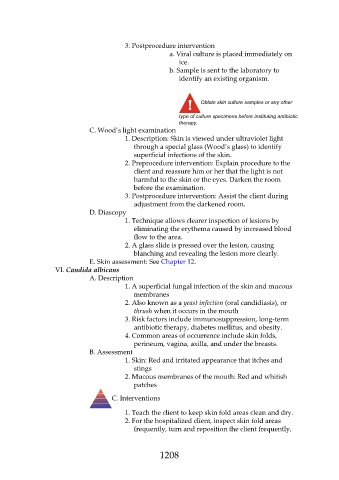Page 1208 - Saunders Comprehensive Review For NCLEX-RN
P. 1208
3. Postprocedure intervention
a. Viral culture is placed immediately on
ice.
b. Sample is sent to the laboratory to
identify an existing organism.
Obtain skin culture samples or any other
type of culture specimens before instituting antibiotic
therapy.
C. Wood’s light examination
1. Description: Skin is viewed under ultraviolet light
through a special glass (Wood’s glass) to identify
superficial infections of the skin.
2. Preprocedure intervention: Explain procedure to the
client and reassure him or her that the light is not
harmful to the skin or the eyes. Darken the room
before the examination.
3. Postprocedure intervention: Assist the client during
adjustment from the darkened room.
D. Diascopy
1. Technique allows clearer inspection of lesions by
eliminating the erythema caused by increased blood
flow to the area.
2. A glass slide is pressed over the lesion, causing
blanching and revealing the lesion more clearly.
E. Skin assessment: See Chapter 12.
VI. Candida albicans
A. Description
1. A superficial fungal infection of the skin and mucous
membranes
2. Also known as a yeast infection (oral candidiasis), or
thrush when it occurs in the mouth
3. Risk factors include immunosuppression, long-term
antibiotic therapy, diabetes mellitus, and obesity.
4. Common areas of occurrence include skin folds,
perineum, vagina, axilla, and under the breasts.
B. Assessment
1. Skin: Red and irritated appearance that itches and
stings
2. Mucous membranes of the mouth: Red and whitish
patches
C. Interventions
1. Teach the client to keep skin fold areas clean and dry.
2. For the hospitalized client, inspect skin fold areas
frequently, turn and reposition the client frequently,
1208

